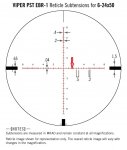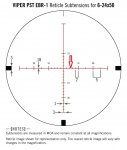The problem is with the imperial system!
This debate will not end until North America finishes inching its way to the metric system. It is the duty of the rest of the world, and already converted Americans, to drag America – kicking and screaming if need be – into the nineteenth century. There, I’ve always wanted to say that.


Unfortunately, when Kiwi shooters walk onto a range, something weird happens to their brains. They too suddenly start to think in terms of inches, footsies, yards, miles or knots. Bizarre


….and discombobulating.

Minutes and Mrads are indeed angular measurements and as such both are equally suitable and usable in the shooting game. Until we start relating them to linear measurements! Some people upthread have suggested avoiding that and just letting angular measurements be angular measurements. That is a fair point and I would be inclined to agree with that. However, that is easier said than done. For instance, we like to relate our group sizes - even if expressed in angular measurements - to the distance from which they are fired. Bingo, linear measurement introduced. Approximately 98.97528 % of shooters (as you all know, 79.64 % of statistics are made up) would - at some point at least - visualise groups in linear terms, even if expressed in angular terms. After all, that bit of paper with those 5 or 10 holes in it is two dimensional. And those callipers measure them in linear measurements.
To say that Mrads can just as easily be used with the imperial system is misleading. Sure, an Mrad projects 1 unit of measure over a distance of 1000 equal units of measure, and whether they are yards, metres, cauliflowers or gumboots is irrelevant. BUT, as soon as you want to cut yards down further, things get unnecessarily complicated. Three footsies in a yard, 36 inches in a yard. I am yet to see a yard stick that cuts a yard down in decimals. And upwards, 1760 yards in mile. Now observe the eloquence of the metric system: there are 10 millimetres in a centimetre, 10 centimetres in a decimetre, 10 decimetres in a metre, 10 metres in a decametre, 10 decametres in a hectometre, and 10 hectometres in a kilometre. One cannot objectively claim that the imperial system is as user-friendly as the metric system, and that it just depends on what you are used to. And therein lies the beauty of Mrads. It too works in decimals. One Mrad projects 758 millimetres over a range of 758 metres. Try that with MOA, and/or with inches or feet or yards or miles.
DCR suggested in post 24 to ‘stop thinking [in terms of imperial or metric] and this whole thing gets a lot easier.’ He then nullified that statement by saying:
‘Learn the formulas so you understand how the math works. Make or buy a mil/moa distance vs size chart then forget the formula. Read the ruler and look up the answer.’
That just shows how deeply ingrained the imperial system is. The almost axiomatic assumption that formulas are required to make things work. Using Mrads AND metrics eliminates the requirement for formulas, and maths (still required when ranging) becomes infinitely simpler and easier.
To conclude, minutes or Mrads as stand-alone units of angular measurements are both fine. However, in the shooting world, it doesn’t take much for linear measurements to be introduced at some level. The essence of the minute for us shooters is the convenient fact that it projects (approximately) 1 inch over 100 yards. As such, the use of minutes is often justified by the use of the imperial system and vice verse. That seems like a circular argument. IMO the demise of the minute is retarded only by the imperial system and related dogma. So, even though Mrads and minutes are angular measurements, the question ‘MOA or Mrad?’ is never about angles. It is always about inches and yards.



